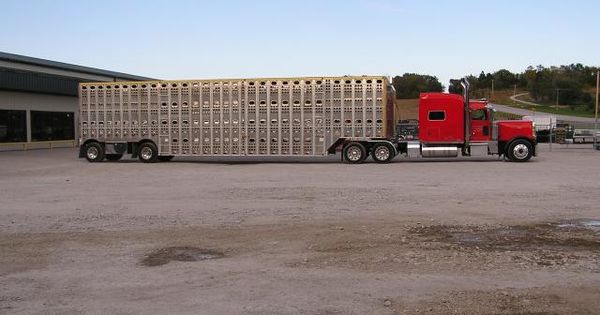Farm & Ranch
Pump the Brakes on MAP-21

By Jessica Crabtree
In July of 2012 a law was signed enforcing the use of federal Electronic Logging Devices (ELDs) by the Department of Transportation’s Federal Motor Carrier Safety Administration (FMCSA) labeled as MAP-21. In this article we will present what is known, how it will affect livestock haulers and projected concerns if MAP-21 goes into effect. By the time this issue prints, the mandate may or may not go into effect, hinging on the chance an exemption is allowed, giving livestock haulers more time to adapt for change.
Why the mandate was proposed.
In a recent article by Drovers on www.drovers.com on Nov. 10, 2017, it stated the regulations proposed were in an attempt to create safer driving conditions and aid in eliminating the need for paper logs.
Why would MAP-21 not work for livestock haulers?
In the ELD rule, truckers have an hourly service limit. Plainly put, truckers have a service limit of 11 hours of driving in a 24-hour period. They can be on duty a total of 14 hours consecutively, including the 11 hours of driveling time said above. After those 11 hours are reached, the driver must stop and rest, allowing for 10 consecutive hours off duty.
Where things get difficult for livestock haulers is in the matter of hauling living creatures. Such rules raise animal welfare concerns. Why some may ask? Due to the chance of cross contamination and unintentional biosecurity hazards.
Particulars about MAP-21.
For commercial motor vehicles, as of Dec. 18, 2017, the federal Electronic Logging Device (ELD) rule, which is regulated by the United States Department of Transportation (DOT), will begin. An ELD is a record-keeping device that is synchronized to the truck’s engine and has the capability to log information digitally in real-time. An ELD is able to record data, such as time spent on the road, number of miles driven, location and amount of hours the engine was running. While this may not be an issue for truckers transporting paper goods, clothing items and non-perishable things, it is not feasible for the welfare of livestock hauling. The voluntary introductory phase for ELDs began Dec. 16, 2015.
To read more about MAP-21 pick up a copy of the January 2018 NTFR issue. To subscribe call 940-872-5922.
Farm & Ranch
Managing Show Cattle Through The Winter

By Heather Welper
Husband and wife duo, Heather and Calvin Welper, are the Co-Owners and Operators or Two C Livestock, located in Valley View, Texas.
The pair’s operation has a show cattle focus where they raise and sell purebred heifers of all breeds and club calf Hereford steers.
When it comes to show cattle, the Welpers know a thing or two including how to prepare for the cold winter months and the Texas major show season run.
To read more, pick up a copy of the November edition of North Texas Farm & Ranch magazine, available digitally and in print. To subscribe by mail, call 940-872-5922.

Farm & Ranch
Double M Ranch & Rescue

By Hannah Claxton, Editor
As the sun rises each day, so do the dozens of mouths that Meghan McGovern is responsible for getting fed. Rather than the sounds of a rooster crowing, McGovern hears the bellows and bleats of a variety of exotic deer, the chortle of kangaroos, the grunts of water buffaloes, and the chirps of a lemur.
Nestled against the banks of the Red River, the Double M Ranch and Rescue, with its high game fences and deer sprinkling the landscape,s its in stark contrast to the surrounding ranches.
“Having deer is kind of like eating potato chips- you can never actually have just one,” said McGovern with a laugh.
McGovern has several herds to take care of- fallow deer, axis deer, water buffalo, goats, and bison. In smaller numbers, there’s also a few kangaroos, a lemur, a potbelly pig, a pair of zebras, a watusi, and a few horses.
To read more, pick up a copy of the November edition of North Texas Farm & Ranch magazine, available digitally and in print. To subscribe by mail, call 940-872-5922.

Farm & Ranch
Acorn Toxicity

By Barry Whitworth, DVM, MPH
With the prolonged drought, most pastures in Oklahoma end up in poor condition. With the lack of available forage, animals may go in search of alternative foods.
If oak trees are in the pastures, acorns may be a favorite meal for some livestock in the fall. This may result in oak poisoning.
Oak leaves, twigs, buds, and acorns may be toxic to some animals when consumed.
To read more, pick up a copy of the November edition of North Texas Farm & Ranch magazine, available digitally and in print. To subscribe by mail, call 940-872-5922.

-

 Country Lifestyles2 years ago
Country Lifestyles2 years agoScott & Stacey Schumacher: A Growth Mindset
-

 Country Lifestyles8 years ago
Country Lifestyles8 years agoStyle Your Profile – What your style cowboy hat says about you and new trends in 2017
-

 HOME8 years ago
HOME8 years agoGrazing North Texas – Wilman Lovegrass
-

 Outdoor10 years ago
Outdoor10 years agoButtercup or Primrose?
-

 Country Lifestyles5 years ago
Country Lifestyles5 years agoAmber Crawford, Breakaway Roper
-

 Equine1 year ago
Equine1 year agoThe Will to Win
-

 Country Lifestyles9 years ago
Country Lifestyles9 years agoJune 2016 Profile – The man behind the mic: Bob Tallman
-

 Country Lifestyles8 years ago
Country Lifestyles8 years agoDecember 2016 Profile, Rusty Riddle – The Riddle Way




